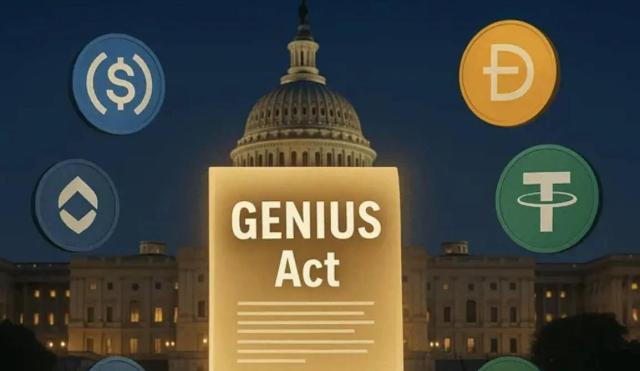Original Author: Yang Ge Gary
During Q2 25, around several Crypto conferences in North America, on the 19th, the U.S. Senate passed the procedural advancement of the GENIUS Act (Guiding and Establishing National Innovation for Stablecoin) with 66 votes in favor and 32 against. Within less than a week, various financial and Crypto institutions rapidly iterated, as a friend put it, the entire market was stirring.
The uniqueness of this act lies in its potential to significantly impact global short-term and long-term financial economics, with multiple layers gradually accumulating, much like a major earthquake close to the earth's surface. If the GENIUS Act is successfully implemented, it will cleverly mitigate the impact of Crypto on the existing financial and economic status of the U.S. dollar and U.S. bonds, and conversely promote the growth of the U.S. dollar's linkage to Crypto Market value and liquidity, essentially utilizing the existing advantages of the U.S. dollar price anchor to transform into long-term value anchor advantages, making the name "Genius" truly deserved.
tl;dr
1. The essential causes of declining traditional U.S. dollar control
2. Understanding the choices and strategic retreat under the trend of Crypto driving global monetary system transformation
3. The nominal and substantive purposes of the GENIUS Act
4. The implications of DeFi reStaking for the fiat world and the monetary multiplier of shadow currency
5. Gold, U.S. dollar, and Crypto stablecoins
6. Global market feedback and financial transaction and asset changes after the act's implementation
[The rest of the translation follows the same professional and precise approach, maintaining the specific terminology as instructed.]4. DeFi reStaking's Insights for Fiat World and Shadow Currency's Money Multiplier
A partner from an asset side told me last week that the next stage of global finance faces great challenges, requiring dual cognition and cross-understanding of traditional finance and Crypto, otherwise one will quickly be eliminated by the market. Indeed, in the DeFi development of the past two cycles, the Crypto Market has independently evolved a set of digitally protocolized professional economic science system, where the protocol logic, Tokenomics, financial analysis methods and tools, and business model complexity have far exceeded the traditional financial system. Although Crypto DeFi differs from traditional finance, it still constantly needs the traditional financial experience system for correction and comparison during development. The two learn from each other, develop rapidly, continuously couple, and form a new financial system.
The proposal of the GENIUS bill has high similarity with DeFi's Staking, reStaking, and LSD in past cycles, or can be seen as another extension of the same methodology in the fiat world.
An example in DeFi: Using ETH through Lido to obtain rebase stETH, staking stETH on AAVE to get USDC worth 70% of the staking value, then using the obtained USDC to enter the market and continue buying ETH. The repeated operation of this ideal model is a geometric series with q = 0.7, ultimately achieving a 3.3x money multiplier.
The above process can be implemented on the fiat stablecoin basis shortly after the GENIUS bill: Suppose a Japanese financial institution outside the US stakes US Treasury bonds to issue USDJ under compliance conditions, obtains JPY through off-ramp and exchanges to USD, then purchases US Treasury bonds to form a cycle. In the repeated operation, there are several assumed multipliers: first, the staking rate (possibly full amount, discounted, or over-collateralized), second, on/off-ramp and exchange friction, third, market outflow rate. After calculating all these, a geometric multiplier q for a single cycle can be obtained, ultimately calculating the money multiplier 1/(1-q). This multiplier is the ideal financial amplification money multiplier that the GENIUS bill and subsequent stablecoin bills of various countries might obtain for US dollar and US Treasury bond holdings.
Of course, this does not include potential over-issuance by non-standard institutions and other shadow assets obtained through further reStaking of stablecoin-invested asset tokens. The flexibility of stablecoins will far exceed the derivatives market of the fiat world, and "stablecoin asset nesting" will undoubtedly bring unimaginable impact to the traditional financial market.
(Translation continues in the same manner for the remaining text)







